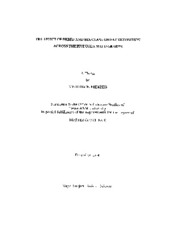| dc.description.abstract | Feeder lambs (n = 90) were selected to represent the five USDA yield grades (YG). Ewes and wethers (n=15 for each group) were selected from Suffolk, F 1 (Suffolk X Commercial Rambouillet first cross), and Commercial Rambouillet. Lambs were sorted randomly into one of five YG treatments and placed on a finishing diet. A three-member team of trained livestock evaluators estimated fat thickness in the live lambs. Lambs were slaughtered according to appropriate humane slaughter methods at staggered intervals when evaluators determined that the lambs had reached their assigned endpoint. All carcasses were evaluated for USDA quality and yield grade at 48 hours postmortem. Carcasses were fabricated into a rough leg, loin, rack, shoulder, neck, breasts, shanks, plates, and flanks. The rough subprimals were then split into right and left sides and all right side subprimals were physically dissected into dissectable lean, bone, and fat (subcutaneous, seam, and internal). Dissectable tissues were weighed for each subprimal. Analysis of variance of the means revealed that breed was significant for virtually all subprimals. Sex class was significant for most bone weights and percentages. Mean analysis of percentage total, subcutaneous, seam, and internal fat and percentage lean and bone reveals the high variability between breeds and sex classes within the five yield grades. Regression equations were developed to predict compositional development of percentage lean, bone, and fat (total, subcutaneous, seam fat, and internal) given actual fat thickness. These equations revealed that Suffolk lambs had lower percentages of total and subcutaneous fat than Commercial Rambouillet and Fl lambs, respectively. Commercial Rambouillet lambs were lower for percentage seam fat than Suffolk and Fl lambs, respectively. Carcasses from ewes were slightly higher than their wether counterparts for total, subcutaneous, and internal fat, and percentage lean. Wether carcasses had more seam fat and bone than ewe carcasses. Across the five yield grades, breed and sex-class impact the ultimate composition of lambs. | en |


